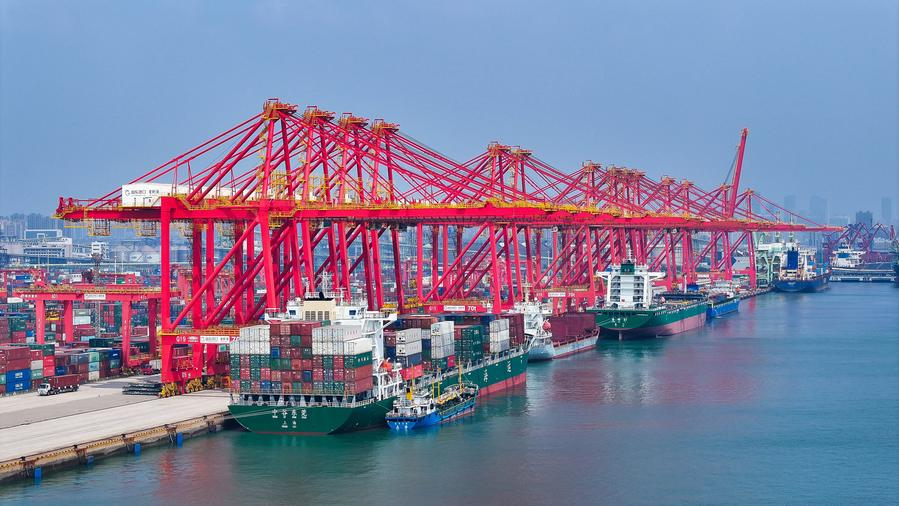
The view of the container terminal of Rizhao Port in Rizhao, east China's Shandong Province, August 22, 2024. [Photo/Xinhua]
By Ibrahim Khalil Ahasan
One of the key components of every nation's economic resiliency is the expansion of its foreign trade. The foreign trade growth has also been inextricably tied to China's economic resiliency and stability. Recent data from China's General Administration of Customs shows the country's foreign trade has continued to improve in the first three quarters of 2024. This growth indicates China's strong economic resilience driven by its market-oriented foreign trade policy, the continuing reform and opening-up and the growing demand for Chinese goods around the world. All have boosted China's economic performance and its global trade presence.
From January to September this year, China's imports and exports totaled 32.33 trillion yuan (about $4.57 trillion), up 5.3 percent year on year despite some external challenges, such as the decoupling attempt by some Western countries and the global economic slowdown. The factors behind the growth include the global popularity of Chinese products, their high quality and competitiveness, and China's willingness to close the trade deficit with countries that have a trade deficit with the nation. As the domestic economy continues to improve and the demand in the exports market picks up speed, both imports and exports saw notable rise, denying some counties' decoupling noises and protectionist moves.
The growth figures show that China's foreign trade growth and recovery is still going strong, with imports increasing by 4.1 percent year on year to 13.71 trillion yuan and exports by 6.2 percent to 18.62 yuan in the first three quarters. China is constantly looking for new markets for both traditional and advanced goods and services, including advanced manufacturing, electronics, cutting-edge products, among others. The world's second largest economy also promotes domestic economic activities and paves the way for the growth of private enterprises. As a result, foreign trade figures will continue to accelerate steadily in the upcoming months.
During the period, mechanical and electrical products remained the dominant force in China's exports, making up nearly 60 percent of the total. Despite Western protectionism, the "new three" – electric vehicles (EV), lithium batteries and photovoltaic products – reached 757.83 billion yuan in exports, accosting for 4.1 percent of total export value. Their contribution will continue to grow in the international market, as China consistently seeks to expand its market share and the global push toward green development is evident. Meanwhile, China's trade with over 160 countries and regions have also achieved growth in the first three quarters.

An exhibitor introduces a piece of jade artifact to a visitor at the 18th China-ASEAN Expo in Nanning, capital of south China's Guangxi Zhuang Autonomous Region, September 10, 2021. [Photo/Xinhua]
The markets for Chinese goods in ASEAN, the Middle East, and the Belt and Road Initiative (BRI) partner countries are expanding daily. China's global trade has increased largely due to the expansion of export markets, making Chinese goods even more popular and competitive. China's expanding use of currency swaps, trade agreements and growing trade with countries participating in the BRI and the Regional Comprehensive Economic Partnership (RCEP) are starting to take effect and are likely to continue supporting China's exports in the months ahead.
China's trade with BRI partner countries grew by 6.3 percent reaching 15.21 trillion yuan and accounting for 47.1 percent of its total trade volume. Trade with ASEAN members, as well as with the EU and the U.S. has also increased. Furthermore, the drive to diversify supply chains from Western nations to the Global South may further boost China's manufacturing export industry and support its long-term economic growth.
Meanwhile, China has been working to reduce trade imbalance with foreign nations. To promote shared development, China will implement zero-tariff treatment for all goods coming from all least developed countries that have diplomatic ties with China starting on December 1, 2024.
The growing contribution of private businesses to the expansion of its foreign trade is particularly noteworthy. In the first three quarters, imports and exports by China's private firms grew by 9.4 percent to 17.78 trillion yuan, contributing 93.8 percent to the overall growth of foreign trade. This highlights the Chinese government's equitable treatment and protection of private sector companies, benefitting all economic sectors and encouraging fair market participation by private enterprises.
Although the first three quarters of 2024 have shown encouraging signs of a rebound in China's international trade, sustained efforts to diversify markets, boost demand, improve competitiveness and adjust to shifting global trade dynamics will be crucial to maintaining this momentum. With recently launched policies aimed at boosting exports and trade performance, China is well-positioned to its growth.
Driven by the combination of these policies and the stimulus measures announced in late September, the fourth quarter is expected to show steady import and export performance. The goal of high-quality development and achieving 5 percent annual GDP growth is undoubtedly within reach.
Ibrahim Khalil Ahasan, a special commentator on current affairs for CGTN, is a Bangladesh-based independent columnist and freelance journalist who writes on contemporary international issues.

 中文
中文



